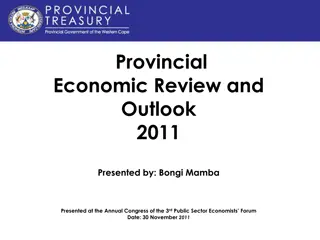
Wilderness Preservation Benefits and Measurement in Vermont
Explore the benefits and costs of wilderness preservation in Vermont through environmental economics. Learn about market and non-market benefits, consumer surplus, measuring techniques, biases, and more in this insightful analysis. Discover the methods used to measure the value of wilderness and the importance of distinguishing between different types of benefits.
Download Presentation

Please find below an Image/Link to download the presentation.
The content on the website is provided AS IS for your information and personal use only. It may not be sold, licensed, or shared on other websites without obtaining consent from the author. If you encounter any issues during the download, it is possible that the publisher has removed the file from their server.
You are allowed to download the files provided on this website for personal or commercial use, subject to the condition that they are used lawfully. All files are the property of their respective owners.
The content on the website is provided AS IS for your information and personal use only. It may not be sold, licensed, or shared on other websites without obtaining consent from the author.
E N D
Presentation Transcript
Environmental Economics Welcome back!
Environmental Economics Measuring benefits and costs The benefits and costs of wilderness preservation in Vermont
Environmental Economics Measuring benefits and costs How do we distinguish between market and nonmarket benefits of wilderness in VT? Market benefits can be measured from market activity Non-market benefits must be measured by revealed or stated preference
Environmental Economics Measuring benefits and costs The nonmarket benefits of wilderness in VT USE value Logging vs. recreation OPTION value The possibility of keystone species EXISTENCE value Our obligation to a connected earth
Consumer surplus from preservation Environmental Economics Demand = WTP Q0 Q1 Acres of wilderness WTP for increase in public good consumer surplus
Environmental Economics Measuring benefits and costs The benefits of wilderness in VT The travel cost method WTP for recreation at Bread Loaf Revealed preference The hedonic pricing method WTP for housing prices The contingent valuation method Stated preference WTP for option and existence value
Environmental Economics Measuring benefits and costs Five potential biases of the CV method Prospect theory
Consumer surplus from preservation Environmental Economics Demand = WTA? Q0 Q1 Acres of wilderness How might this contrast to WTA from going from Q1 to Q0?
Environmental Economics Measuring benefits and costs Five potential biases of the CV method Prospect theory Free-riding Strategic Embeddedness Hypothetical
Environmental Economics Measuring benefits and costs Risk assessment and the valuation of life Epidemiological studies Animal studies Dose-response model Conservative modeling the right approach?
Environmental Economics Measuring benefits and costs Risk assessment and the valuation of life Overall risk = actual risk (1.4/10,000 for car accidents) * number of people exposed (300,000,000) = 42,000 deaths The role of perception and control Lack of knowledge Risk aversion and the insurance motive
Environmental Economics Measuring benefits and costs The total costs of environmental policy Engineering costs overstated if Regulation increases productivity Creates green jobs Engineering costs understated if .. Regulation decreases productivity Increases unemployment Increases moonopoly power
Environmental Economics Measuring benefits and costs The indirect costs of environmental policy? Productivity impacts and the Porter Hypothesis Very little (if any) negative effects (Meyer 1993) The jobs environment trade-off? While there are losers, this effect is way over-hyped Pollution havens?
Environmental Economics Measuring benefits and costs The hidden costs of environmental policy Monopoly costs The example of waste management The double-dividend controversy 1. Correcting for externalities raises prices 2. Higher prices lower real wages 3. Lower real wages means less output
SMC = PMC + E Environmental Economics Society s net benefits = A - B Consumer surplus cost of externality PMC A B P0 Demand Producer surplus C Q0 Corn (bushels/year) We can show that a pollution tax increases welfare
PMC (with tax) Environmental Economics Society s net benefits = A Consumer surplus Tax revenues Pollution tax PMC PC A DWL P0 PS Demand Producer surplus Q1 Q0 Corn (bushels/year) BUT the pollution tax, which increases welfare, raises prices
Environmental Economics Measuring benefits and costs The hidden costs of environmental policy Monopoly costs The example of waste management The double-dividend controversy 1. Correcting for externalities raises prices 2. Higher prices lower real wages 3. Lower real wages means less output
Nominal wage ($ per hour) Environmental Economics D (without payroll tax) Labor supply W1 W0 DWL D' (with payroll tax) Q1 Q0 Labor (hours) The double dividend should come from lowering the payroll tax
Labor supply (higher prices) Net increase of DWL in labor market Nominal wage ($ per hour) Environmental Economics Labor supply W2 D'' (lower tax) W0 DWL W1 D D' Q2 Q1 Q0 Labor (hours) But with higher prices, the last dollar earned at work is worth less . so, at the margin, people will work less and relax more.
Environmental Economics Measuring benefits and costs The hidden costs of environmental policy The double-dividend controversy Benefit from lowering pollution in the goods market Benefit from lowering distortions in the labor market Cost from lowering output from labor market The current debate: how big is the output cost? Double dividend
Environmental Economics Benefits and costs of policies The use of BC analysis Not used (by statute) for air, water and hazardous waste safety standard Used for pesticides, insecticides, and other toxics efficiency standard Yet benefits and costs still estimated and part of public policy debate
Environmental Economics Benefits and costs of policies A September 2011 study from the EPI The combined annual benefits from three major proposed rules examined here exceed their costs by $62 billion to $188 billion a year. The benefit/cost ratio ranges from 6-to-1 to 15-to-1. When fully in effect in 2014, the combined costs of the major rules finalized by the Obama administration s EPA would amount to significantly less than 0.1% of the economy.
Environmental Economics Benefits and costs of policies Some common sense guidelines The eight principles of Arrow et al. (1996) 1. Useful for comparing favorable and unfavorable effects 2. Not precluded from using 3. Required for major decisions
Environmental Economics Benefits and costs of policies Some common sense guidelines The eight principles of Arrow et al. (1996) 4. Not bound by benefit-cost tests 5. Benefits and costs quantified wherever possible, with uncertainties identified Values of affected individuals
Environmental Economics Benefits and costs of policies Some common sense guidelines The eight principles of Arrow et al. (1996) 6. External reviews desirable 7. Core set of assumptions Discount rate, reducing risk of death and accidents, values of improved health 8. Distributional consequences
Environmental Economics The potential use of DDT and GMOs What standard is appropriate? What discount rate is appropriate? How measure benefits? How measure costs? Should the cost-effective solution be adopted? What do you recommend?
Environmental Economics Benefits and costs of policies Some common sense guidelines The eight principles of Arrow et al. (1996) 1. Useful for comparing favorable and unfavorable effects 2. Not precluded from using 3. Required for major decisions
Environmental Economics Benefits and costs of policies Some common sense guidelines The eight principles of Arrow et al. (1996) 4. Not bound by benefit-cost tests 5. Benefits and costs quantified wherever possible, with uncertainties identified Values of affected individuals
Environmental Economics Benefits and costs of policies Some common sense guidelines The eight principles of Arrow et al. (1996) 6. External reviews desirable 7. Core set of assumptions Discount rate, reducing risk of death and accidents, values of improved health 8. Distributional consequences
Environmental Economics Benefits and costs of policies The case of Obama EPA rules What are the main conclusions of the EPI report? What other approaches could be used to assess the effectiveness of these rules besides benefit-cost analysis? Should these approaches be used as a substitute or a complement to benefit-cost analysis? Defend your answer.
Environmental Economics Benefits and costs of policies Controlling the impacts of consumption Consumption tax? Mandated vacations? Regulation of advertising?
Environmental Economics The potential use of DDT and GMOs What standard is appropriate? What discount rate is appropriate? How measure benefits? How measure costs? Should the cost-effective solution be adopted? What do you recommend?
Environmental Economics Incentive-based regulation A three-step approach 1. Set standard Efficiency, safety or ecological sustainability 2. Recognize limits of governance Imperfect information, political influence, inadequate enforcement 3. Look for ways to do better! IB policies and clean technology
Environmental Economics Incentive-based regulation One of the most significant successes of economics since 1970 At Earth Day 1970, economists were ready! A dramatic, encouraging learning curve In 2011, economists are wiser
Environmental Economics Incentive-based regulation The typical C&C system Identify the polluting activity and polluters Designate an ambient standard Mandate types of technology Best Available Control Technology (BACT) Very frequent in USA since 1970 Example: the original Clean Air Act (CAA)
Environmental Economics Incentive-based regulation The cost effectiveness rule (p. 304) Cost effectiveness is achieved if and only if the marginal cost of reduction is equal for each pollution source
Environmental Economics Incentive-based regulation The evolution of IB policy instruments Green (Pigouvian) taxes Tradable permits Information based regulation
Environmental Economics Incentive-based regulation Green taxes Calculate the marginal social damage Tax the polluting activity at that rate Use revenues to offset other taxes More frequent in EU and developing world Example: Australia s new carbon tax
Environmental Economics Incentive-based regulation Tradable permits Calculate the desired quantity of emissions Issue and/or sell this amount of permits Monitor market and enforce activity Growing rapidly in US and developing world Example: CO2emissions in the EU . and in New England (RGGI) and California (AB 32)
Environmental Economics Incentive-based regulation The cost effectiveness rule (p. 304) The Coase corollary (p. 311) If there is a well-functioning permit market, a cost-effective outcome will be achieved by a marketable permit system regardless of the initial allocation of permits.
Environmental Economics Incentive-based regulation Costs with taxes and permits Two firms: green (25 tons of emissions) and brown (150 tons of emissions) Social goal: reduce emissions from 175 tons to 100 tons Two alternatives: tax at $60 per ton or give 50 (per ton) permits to each firm
Costs for green firm with taxes and permits $ $ Environmental Economics Tax payments = $60*10 = - $600 Abatement cost = $60*15*1/2 = - $450 Total cost = - $1050 MACG $100 $60 Qe = 25 Qe* = 10 Quantity of emissions
$ Costs for brown firm with taxes and permits $ $ Environmental Economics $150 Tax payments = $60*90 = $5400 Abatement cost = $60*60*1/2 = $1800 Total cost = $7200 MACK $60 Qe** = 90 Qe = 150
Costs for green firm with taxes and permits $ $ Environmental Economics Permit sales= $60*40 = + $2400 Abatement cost = $60*15*1/2 = - $450 Total revenue = + $1950 MACG $100 $60 Qe* = 10 Qe = 25 Qp = 50 Quantity of emissions
$ Costs for brown firm with taxes and permits $ $ Environmental Economics $150 Permit cost = $60*40 = $2400 Abatement cost = $60*60*1/2 = $1800 Total cost = $4200 MACK $60 Qp = 50 Qe** = 90 Qe = 150
Environmental Economics The brown firm asks: should we go green? Should they make this investment? If the NPV of Benefits > Initial cost $ Annual cost savings Tax ($10) Tax payments MAC CA 0 20 Quantity of emissions Long-run cost savings and pollution reduction with green tax
Potential problems with IB-systems Both taxes and permits Environmental Economics Hot spots (non-uniformly mixed pollutants) Monitoring and compliance Permits only Thin markets and high transactions costs Development of market power Relocation effect The potential of limited permit life
Potential problems with IB-systems Environmental Economics Taxes only The need to change the tax rate The political setting (in the USA)
Environmental Economics Incentive-based regulation How to deal with uncertainty? When the marginal benefit of abatement is relatively steep you want to stick your landing!






















